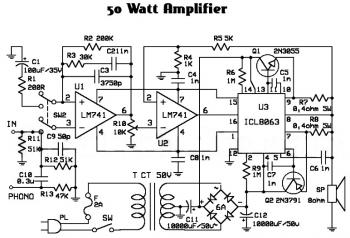Description
Notes:
Output power (1 KHz sine wave):
Some lovers of High Fidelity headphone listening prefer the use of
battery powered headphone amplifiers, not only for portable units but
also for home “table” applications. This design is intended to fulfill
their needs. An improved output driving capability is gained by making
this a push-pull Class-B arrangement. Output power can reach 100mW RMS into a 16 Ohm load at 6V supply with low standing and mean current consumption, allowing long battery duration.
Circuit Diagram
Parts- P1 = 22K Potentiometer
- R1 = 15K Resistor
- R2 = 100K Resistor
- R3 = 100K Resistor
- R4 = 47K Resistor
- R5 = 470R Resistor
- R6 = 500R Resistor
- R7 = 1K Resistor
- R8 = 18K Resistor
- R9 = 18K Resistor
- R10 = 2.2R Resistor
- R11 = 2.2R Resistor
- R12 = 33R Resistor
- R13 = 4.7K Resistor
- C1 = 10uF-25V Capacitors
- C2 = 10uF-25V Capacitors
- C3 = 100nF-63V (PF)
- C4 = 220uF-25V Capacitors
- C5 = 100nF-63V (PF)
- C6 = 220uF-25V Capacitors
- Q1 = BC560C PNP Transistor
- Q2 = BC560C PNP Transistor
- Q3 = BC550C NPN Transistor
- Q4 = BC550C NPN Transistor
- Q5 = BC560C PNP Transistor
- Q6 = BC327 PNP Transistor
- Q7 = BC337 NPN Transistor
- J1 = RCA Audio Input Socket
- J2 = 3mm Stereo Jack Socket
- B1 = 6V Battery Rechargeable
- SW1=SPST Slide or Toggle Switch
Notes:
- For a Stereo version of this circuit, all parts must be doubled except P1, SW1, J2 and B1.
- Before setting quiescent current rotate the volume control P1 to the minimum, Trimmer R6 to maximum resistance and Trimmer R3 to about the middle of its travel.
- Connect a suitable headphone set or, better, a 33 Ohm 1/2W resistor to the amplifier output.
- Switch on the supply and measure the battery voltage with a Multimeter set to about 10Vdc fsd.
- Connect the Multimeter across the positive end of C4 and the negative ground.
- Rotate R3 in order to read on the Multimeter display exactly half of the battery voltage previously measured.
- Switch off the supply, disconnect the Multimeter and reconnect it, set to measure about 10mA fsd, in series to the positive supply of the amplifier.
- Switch on the supply and rotate R6 slowly until a reading of about 3mA is displayed.
- Check again the voltage at the positive end of C4 and readjust R3 if necessary.
- Wait about 15 minutes, watch if the current is varying and readjust if necessary.
- Those lucky enough to reach an oscilloscope and a 1 KHz sine wave generator can drive the amplifier to the maximum output power and adjust R3 in order to obtain a symmetrical clipping of the sine wave displayed.
Output power (1 KHz sine wave):
- 16 Ohm: 100mW RMS
- 32 Ohm: 60mW RMS
- 64 Ohm: 35mW RMS
- 100 Ohm: 22.5mW RMS
- 300 Ohm: 8.5mW RMS
- 160mV input for 1V RMS output into 32 Ohm load (31mW)
- 200mV input for 1.27V RMS output into 32 Ohm load (50mW)
- Flat from 45Hz to 20 KHz, -1dB at 35Hz, -2dB at 24Hz
- 1V RMS (62mW) 0.015% 1.27V RMS (onset of clipping, 100mW) 0.04%
- 1V RMS (62mW) 0.05% 1.27V RMS (onset of clipping, 100mW) 0.1%
- Unconditionally stable on capacitive load


+Circuit.jpg)





























